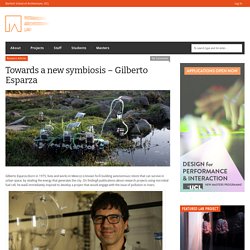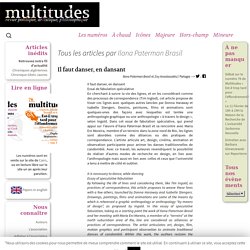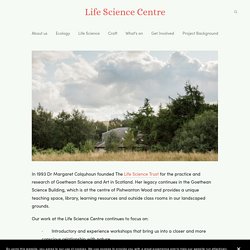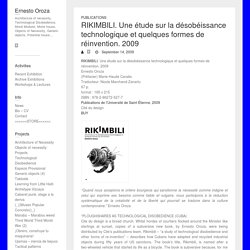

Towards a new symbiosis – Gilberto Esparza. Gilberto Esparza (born in 1975; lives and works in Mexico) is known for building autonomous robots that can survive in urban space, by stealing the energy that generates the city.

On finding publications about research projects using microbial fuel cell, he was immediately inspired to develop a project that would engage with the issue of pollution in rivers. Image profiling Gilberto Esparza Esparza’s Auto-Photosynthetic Plants is an experiment that uses microbial fuel cells to create sound and energy from water samples collected from urban spaces. He created a symphony using an orchestra that has been never given a voice – microscopic bacteria.
The video below shows what Esparza as well as the fuel cells had to say/sing. More information on the project. Using this knowledge on the microbial fuel cell, Gilberto Esparza followed-up with Nomadic Plants, a robot that assumes the image of a domestic animal. VERNACULAIRE - Inventaire Poétique Urbain.
Ilana Paterman Brasil. Il faut danser, en dansant Essai de fabulation spéculative En cherchant à suivre la vie des lignes, et en les considérant comme des processus de correspondence (Tim Inglod), cet article propose de tisser ces lignes avec quelques autres lancées par Donna Haraway et Isabelle Stengers.

Dessins, peintures, films et animations sont quelques-unes des façons avec lesquelles est tentée une anthropologie graphique ou une anthropologie « à travers le design », selon Ingold. Dans cet essai de fabulation spéculative, qui prend appui sur l’œuvre d’Ilana Paterman Brasil et sa rencontre avec Maria Eni Moreira, membre d’un terreiro dans la zone nord de Rio, les lignes sont abordées comme des alliances ou des pratiques de correspondance. L’artiste articule art, design, cinéma, animation et observation participante pour animer les danses traditionnelles de candomblé. In 1993 Dr Margaret Colquhoun founded The Life Science Trust for the practice and research of Goethean Science and Art in Scotland.

Her legacy continues in the Goethean Science Building, which is at the centre of Pishwanton Wood and provides a unique teaching space, library, learning resources and outside class rooms in our landscaped grounds. Our work at the Life Science Centre continues to focus on: · Introductory and experience workshops that bring us into a closer and more conscious relationship with nature. · Teaching Goethean Science on the basis of observational study of nature and natural phenomena. · Research into the Goethean methodology of artistic and scientific enquiry, leading from sense perception to sensorial imagination and insights that can enable us to become co-creative in nature.
Workshop "Devenir plante" à l'X. « Devenir plante » sera un rassemblement d’artistes, physiciens, jardiniers, philosophes, biologistes, médiologues, agriculteurs, historiens et anthropologues – des chercheurs désireux de sortir de leur zone de confort pour renouveler leurs pratiques, protocoles, apprentissages et processus de questionnement. « Devenir plante » permettra de défier notre perception du végétal, d’entrevoir et d’inventer un autre jeu de ficelles à pratiquer avec les plantes : Il ne s’agit plus de simplement nous éclairer sur ce que les végétaux nous apportent, mais de dépasser cet anthropocentrisme et d’imaginer comment nous allons être transformés par elles.

Programme >Workshop "Devenir plante"Le workshop débutera par un rituel végétal de la communauté Cofan de l’Amazonie colombo-équatorienne, réalisé par Jose Sebastian Jansasoy, médecin indigène. Intervenants >Jens Hauser travaille comme commissaire d’expositions et auteur à Copenhague et à Paris. La Gambiarra Basile de Gaulle et Romée de la Bigne. Architecture of Necessity – by Ernesto Oroza – ARCHITECTURE OF NECESSITY_ARQUITECTURA DE LA NECESIDAD_MORAL MODULOR_UPDATING CITY_POTENTIAL HOUSE_OBJECTS OF NECESSITY_OBJETOS DE LA NECESIDAD. Technological Disobedience – Ernesto Oroza. RIKIMBILI.

William Morris Lettre sur la forêt d'EPPING (1895) Ismal Muntaha, Jatiwangi art Factory (JaF), on the Village Art Festival. The Rural: Contemporary Art and Spaces of Connection - Whitechapel Gallery. Inland. Edited by Myvillages Part of the acclaimed Documents of Contemporary Art series of anthologies which collect writing on major themes and ideas in contemporary art.

"Finally a serious and current (rather than nostalgic) analysis of rural culture and environment. The problematic relationship between contemporary art and rural land and lives is too often defined by urban viewpoints. The variety of approaches in this book open a whole new and respectful field that is not as far afield as it seems. " -Lucy R. JAF x George Clark - Residency. By Ismal Muntaha, Curator As a part of the New Commissions Fund 2018-2019 project, last May I visited London, Leeds, and Marsden for a three-week residency together with Bunga Siagian, representing Jatiwangi Art Factory (JAF), to develop several ideas for our collaborative project with George Clark, Village Video Festival: Tools for Conviviality.

Not only it helped us determine the themes of the festival, it also gave us the opportunity to engage with diverse communities and establish new collaborations between artists and organisations in Indonesia and the UK. During the first week of our residency, artist, curator and writer George Clark took us around a village in England called Marsden, which helped us understood how industries in the village played a major role in shaping Marsden’s cultural landscape.